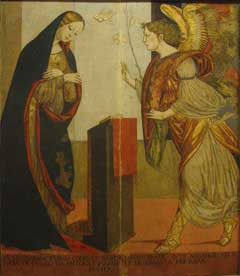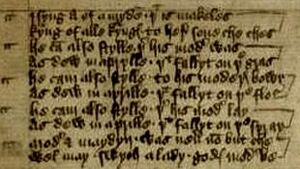I syng of a mayden facts for kids
"I syng of a mayden" is a famous old poem from the 1400s. It's also known as "As Dewe in Aprille". This poem is a type of song called a carol. It was written in Middle English, which is an older form of the English language.
The poem celebrates two important events from the Bible. These are the Annunciation and the Virgin Birth of Jesus. The Annunciation is when the Angel Gabriel told Mary she would have a baby. The Virgin Birth means Jesus was born when Mary was still a virgin. People say it is one of the most loved short English poems from the late Middle Ages.
No one knows who wrote this poem. It was written by an unknown person. Today, the only copy of the poem is in the Sloane Manuscript 2593. This is a collection of old songs and poems kept at the British Library in London. Even though only one copy exists now, people at the time knew the poem very well. It was meant to be sung, but its original music is now lost. Many modern musicians have created new music for it.
Where the Poem Comes From
The Sloane Manuscript 2593 holds the poem. It is kept at the British Library. Experts believe the manuscript was made around the year 1400. They think the poems might have belonged to a traveling singer.
Other poems in this old book include "I have a gentil cok" and "Adam lay i-bowndyn". There are also two riddle songs. One is called "A minstrel's begging song." The other is "I have a yong suster." A scholar named Joseph Glaser says this manuscript has the only copies of several very important poems.
In 1836, a historian named Thomas Wright studied the manuscript. He thought some poems might be even older than the 1400s. Based on the old English words used, he guessed the poems came from Warwickshire. He also thought some songs were used in mystery plays. These were religious plays performed in medieval times.
More recent studies suggest the poems came from East Anglia, especially Norfolk. Other old songbooks from Norfolk have copies of poems found in Sloane 2593. However, "I syng of a mayden" is only found in this one manuscript.
Another scholar, W. W. Greg, noticed something interesting. This poem is very similar to a much older poem from the 1200s. That poem is kept at Trinity College, Cambridge. It is likely that the similarity is not just a coincidence.
In 1978, Alan J. Fletcher found something else. A writer named Selk quoted the end of the poem in his sermons. This shows that the poem was well-known back then. Selk wrote:
- Mayde, Wyff and Moder whas neure but ye
- Wel may swych a ladye Goddys modyr be.
This means: "Maid, wife, and mother was never but you / Well may such a lady God's mother be."
Music for the Poem
The poem itself says it was meant to be sung. The first part of the poem even sounds like it has a tune. But because people passed songs down by memory, the original music was never written down. Over time, it was forgotten.
Since the poem was found again, many composers have created new music for it. These include Martin Shaw, Patrick Hadley, Roger Quilter, and Gustav Holst. Benjamin Britten used it in his famous work Ceremony of Carols. He called his version "As Dewe in Aprille."
Other composers who set the poem to music include Arnold Bax, Peter Warlock, and Lennox Berkeley. John Adams used it in his opera El Niño. The group Mediaeval Baebes also performs the work. A musical setting by Miklós Rózsa was even used in the 1953 film Knights of the Round Table.



